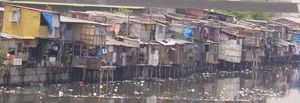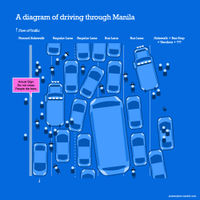User:Joe9320/UnVoyage:Manila
The city of Manila (Maynila in Filipino, Manira in Japanese) is the number two largest city in Southeast Asia, the world's second largest rubbish dump after New Jersey and the capital of the Philippines. A combination of Spanish, American and Malay cultures, as well as its persistent pollution, poverty, traffic and crime, Manila is often known as Jakarta's half-built replica because both cities share the same problems as each other, and also because Imelda Marcos wasted all of the money on buying shoes instead of finishing the replica of Jakarta planned after a certain president called Garcia was jealous of Jakarta's size and its buildings.
However, since most inhabitants do not understand basic mathematics due to the falling standards of education for the poor as well as the government's slow response to the trend, Manila is now a metropolis consisting of more than 7000 cities despite actually having 16 cities and one municipality that doesn't count since most municipalities in the Philippines have small people and small populations, and every other municipality in Metro Manila became a city. Because you need half a million people to form a city to meet the statistics bureau's classification. Indeed it's more fun in the Philippines when it comes to everything.
Understand[edit | edit source]
History[edit | edit source]
Nobody knows how Manila came into being, since it was originally just a small village with a couple of huts, fishermen and traders who are there to trade shit from the Chinese, Arabs, Javanese, Japanese and Indians in return for some of their own shit. There was a kingdom called "Maynila" during the 16th Century, but it was just simply an extension of the sultanate ran by Brunei. Another kingdom was established earlier by the Chinese called "Tondo", but who gives a fuck anyway as it is simply the same kingdom. Besides, the Spanish arrived and ruined things over for the worse. And the islands were named in honor of King Philip II, known for screwing the Spanish economy to the ground a few times, in which this characteristic was given to Ferdinand Marcos and a few other Filipino presidents and congress members to use. However, the Mexicans ruled the Philippines instead and once Mexico became independent, Spain took over.
Talk[edit | edit source]
The inhabitants of Manila speak a variety of languages. The most widely spoken (and official) language is "Taglish", a blend of Tagalog and English that is spoken to confuse foreigners like you and me who go to Manila. The poor speak a dialect of Taglish called "konyo English", which is a language spoken by those who aspire to keep up with the Joneses but cannot afford to do so.
Get in[edit | edit source]
How to get in. By plane, boat, etc.
Get around[edit | edit source]
Bus[edit | edit source]
Definitely a must if you want to experience the REAL Philippines. The age of buses can range from recently bought Chinese buses to 50 year old school buses from the United States of America. These buses plow through the traffic loaded streets around Metro Manila and some even depart from Manila to another destination at some rural place or even a town if you are lucky in Luzon. For maximum enjoyment, we recommend riding on top of the actual bus itself, clinging to dear life as the bus hurtles along at fast speeds of up to 120 km/h[1]. Just be sure that the bus you are on stops at the illegal bus stops that are not designated by the bureaucratic corrupt dicks at Metro Manila Development Authority (or MMDA), because once they get taken down by them, they're gone for good. But never mind, they'll pop up somewhere else at another time.
Train[edit | edit source]
The So-called "Rapid" "Transit" System, or SRTS for short, is a "mass rapid transit system" that operates within Metro Manila. It consists of five lines- three "light" rail and two "heavy" rail lines that service areas unsuitable for habitation by humans, but Filipinos are known to survive in such areas. It is neither quick, nor for the masses, nor a real transit system. So much for a "strong" nation.
- The Manila Light Rail Transit, or "LRT", is the oldest rapid transit system in use in Southeast Asia and is very dangerous to use. The first trains used are hot and stuffy, but now they are all air-conditioned. If you're lucky, there could be a bomb inside one of those trains planted conveniently by some douchebag. Never travel in the LRT alone. There are two lines: Purple Line, which crosses from west to east and ends conveniently just outside Metro Manila near Antipolo City[2] and Yellow Line, so named because of the pee stain found in many of the unisex toilets in every station. More lines are planned so that by the year 2100 the network will be as long as Shanghai's in 2010.
- The Manila Metro Rail Transit transverse across a dangerous road called EDSA, or the Epifanio de los Santos Avenue in an ironic twist. It also has a connection with the Yellow Line and Purple Line.
- Other railway lines had been planned, including the Red Line. It would have been built if that damn Arroyo not tear a new asshole and give the damn money to the companies so that they could build her a new train system. The LRT is operated by an electrical provider whose previous experience was running trams during the America occupation.
- The Philippine National Railway is a state-owned railway that owns the bulk of the used Japanese trains thrown away as
garbagedonations from the Japanese for raping the Philippines and screwing the ladies, and 30-year old hunk-of-shit locomotives from the United States.
Car[edit | edit source]
Get a driver. But not one that rips you off, drugs you when you are talking with him and steals your wallet. However, going by car is really worthless due to the roads being clogged with trash, buses, motorbikes, jeepneys, other cars, shops and actual people. The last one is real. For those who plan to park on one of the many parking spots, we recommend that you try to take up as much parking space as possible, and possibly clog the parking space with rubbish that is readily available in your nearest slum or public building. But do not forget to lock your car as you do in your first world country; it is not uncommon for kids to play around inside and rob your goods. Or adults robbing your goods. Or manchildren playing around in the car and stealing your goods.
References:
- ↑ Note: Bus drivers will not appreciate doing this in Metro Manila, nor will the MMDA. Most Filipinos tend to ride buses inside the cabin itself, and such instances of riding on top is restricted to country bumpkins.
- ↑ And as time of writing, there will be two new stations which will finally give residents of Antipolo City the chance to be screwed over like the Manilenos.
See[edit | edit source]
- This thing is bla bla bla.
- This thing is bla bla bla.
Do[edit | edit source]
- Protests- the favourite pastime amongst many Filipinos, protesting is often done if a vocal minority of Filipino citizens are dissatisfied with the government's plans or even the government itself. The trend began back in 1986 when
FerdinandImelda Marcos, the ruler of the Philippines, was overthrown after days of protesting caused by two people declaring that they are presidents at the same time. - Urinate in public- although it is illegal to urinate in public, despite the signs written in Filipino (and only in Filipino) that says Bawal Umihi Dito (do not urinate here), people often urinate around the walls, on posters (especially political posters) and even old posters of former Metro Manila Development Authority jefe, Bayani Fernando. Got caught? Just say that you don't know Filipino.
- Leave. Now. (see Go next section for more details)
- Buy a cheap hooker: illegal under Philippine law but can be found everywhere. Be sure to check for any penises.
- Buy a permanent residence: you can find stalls in malls in Manila that advertise some new property in development to entice foreign investment, be it an apartment unit or a house in a gated community. Take Uncyclopedia's advice and do not buy any property in the Philippines; you could be ripped off since prices advertised are far higher than the apartment is actually worth.
- Try to find Gloria Macapagal-Arroyo. Currently her location was unknown, but you can play hide-and-seek in the vast metropolis in the hunt for GMA. Last seen by the hospital due to illness.
- Watch a drag queen beauty pageant.
- Jump off from the top of a billboard.
- Drink moderately.
- Take sides in the never-ending and pointless battle between two so-called "media giants".
- Get mugged by the cops: cops can be found at any conveniently-placed checkpoints- be it at spaghetti junction exits, in the middle of the road or even at airports. Or for even better thrills, mug the cops before they mug you.
Buy[edit | edit source]
The currency used around Manila is the Philippines peso.
Manila is known ofr having the most shopping malls per square kilometre: there are around 729 shopping malls for every square kilometre of land.
Eat[edit | edit source]
Filipino cuisine is known to be cooked from ingredients that anyone can find, and toss them into a pot. There is no such thing as fine dining here either; most of the "restaurants" are actually hawker stalls that are set up on open spaces or under busy freeways, with a couple of plastic chairs and tables, umbrellas and a small kitchen. Though this isn't always the case, sometimes Filipino cuisine comes in the form of an actual restaurant, or even fast food restaurants.
Fast Food[edit | edit source]
Due to American imperialism in the early part of the 20th century, the end result of restaurants in the Philippines is that Quizno's Subs, Subway, Pizza Hut, Shakey's, Kenny Roger's and McDonald's cover approximately half of Manila, while the other half of Manila is covered with Jollibee restaurants, which is a Filipino version of McDonald's. In America, fast food is eaten by the poor while the wealthy acan afford to eat a variety of foods such as fruits, vegetables, cereals and meats. The opposite is true in the Philippines: burgers are an often known treat around the area for the ever-increasing middle class and the established wealthy, while the poor have nothing more to eat than a bowl of rice, soup, meat, fish and other healthy foods. Most of the fast food chains in the Philippines can also be found in the U.S. or no longer existing there.
Coca-Cola and Pepsi are very popular in Manila, the former being endorsed by Marcos during the Martial Law era and the Proxy Cola Wars that precede it, while the latter is often ignored or hated because of the Pepsi Lottery Disaster of 1991, when millions of Filipinos received the same winning number and demanded money from PepsiCo.
Breakfast[edit | edit source]
- Eat aborted duck fetus.
Drink[edit | edit source]
same as eat but drinking.
Stay safe[edit | edit source]
How to stay safe in your place.
Respect[edit | edit source]
How to dress.
Contact[edit | edit source]
Numbers to call for help/911.
Go next[edit | edit source]
[[A place to go next]]

